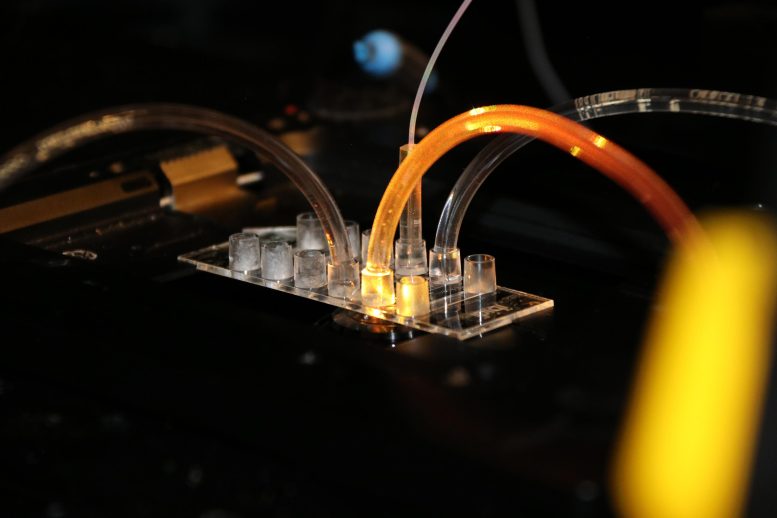Un outil révolutionnaire permettra de répondre aux futures pandémies de manière accélérée.
Un nouvel outil permet de multiplier par plus d’un million le développement de vaccins et d’autres produits pharmaceutiques tout en minimisant les coûts.
À la recherche d’agents pharmaceutiques tels que de nouveaux vaccins, l’industrie examine régulièrement des milliers de molécules candidates apparentées. Une nouvelle technique permet de réaliser cette analyse à l’échelle nanométrique, en minimisant l’utilisation de matériaux et d’énergie. Ces travaux sont publiés dans la prestigieuse revue Nature Chemistry.
Plus de 40 000 molécules différentes peuvent être synthétisées et analysées dans une zone plus petite qu’une tête d’épingle. Cette méthode, mise au point dans le cadre d’un effort de recherche hautement interdisciplinaire au Danemark, promet de réduire considérablement les quantités de matériel, d’énergie et de coûts économiques pour les entreprises pharmaceutiques.
La méthode fonctionne en utilisant des bulles semblables à du savon comme nano-conteneurs. Avec DNA nanotechnology, multiple ingredients can be mixed within the containers.

A new tool speeds up development of vaccines and other pharmaceutical products by more than one million times while minimizing costs. The method works by using soap-like bubbles as nano-containers. With DNA nanotechnology, multiple ingredients can be mixed within the containers. Credit: Nikos Hatzakis, University of Copenhagen
“The volumes are so small that the use of material can be compared to using one liter of water and one kilogram of material instead of the entire volumes of water in all oceans to test material corresponding to the entire mass of Mount Everest. This is an unprecedented save in effort, material, manpower, and energy,” illustrates head of the team Nikos Hatzakis, Associate Professor at the Department of Chemistry, University of Copenhagen.
“Saving infinitely amounts of time, energy and manpower would be fundamentally important for any synthesis development and evaluation of pharmaceuticals,” says PhD Student Mette G. Malle, lead author of the article, and currently Postdoc researcher at Harvard University, USA.
Results within just seven minutes
The work has been carried out in collaboration between the Hatzakis Group, University of Copenhagen, and Associate Professor Stefan Vogel, University of Southern Denmark. The project has been supported by a Villum Foundation Center of Excellence grant. The resulting solution is named “single particle combinatorial lipidic nanocontainer fusion based on DNA mediated fusion” – abbreviated SPARCLD.
The breakthrough involves integration of elements from normally quite distant disciplines: synthetic biochemistry, nanotechnology, DNA synthesis, combinational chemistry, and even Machine Learning which is an AI (artificial intelligence) discipline.
“No single element in our solution is completely new, but they have never been combined so seamlessly,” explains Nikos Hatzakis.
The method provides results within just seven minutes.

The method works by using soap-like bubbles as nano-containers. With DNA nanotechnology, multiple ingredients can be mixed within the containers. Credit: Nikos Hatzakis, University of Copenhagen
“What we have is very close to a live read-out. This means that one can moderate the setup continuously based on the readings adding significant additional value. We expect this to be a key factor for industry wanting to implement the solution,” says Mette G. Malle.
Had to keep things hush-hush
The individual researchers in the project have several industry collaborations, yet they do not know which companies may want to implement the new high-throughput method.
“We had to keep things hush-hush since we didn’t want to risk for others to publish something similar before us. Thus, we could not engage in conversations with industry or with other researchers that may use the method in various applications,” says Nikos Hatzakis.
Still, he can name some possible applications:
“A safe bet would be that both industry and academic groups involved in synthesis of long molecules such as polymers could be among the first to adopt the method. The same goes for ligands of relevance for pharmaceutical development. A particular beauty of the method that it can be integrated further, allowing for direct addition of a relevant application.”
Here, examples could be RNA strings for the important biotech tool CRISPR, or an alternate for screening and detecting and synthesizing RNA for future pandemic vaccines.
“Our setup allows for integrating SPARCLD with post-combinatorial readout for combinations of protein-ligand reactions such as those relevant for use in CRISPR. Only, we have not been able to address this yet, since we wanted to publish our methodology first.”
The scientific article on SPARCLD will be published in the prestigious journal Nature Chemistry on April 4, 2022.
The technology
The SPARCLD method (single particle combinatorial lipidic nanocontainer fusion based on DNA mediated fusion) is a parallelized, multi-step and non-deterministic fusion of individual zepto-liter nano-containers. The research team has observed efficient (more than 93 %) leakage-free fusion sequences for arrays of surface tethered target liposomes with six freely diffusing populations of cargo liposomes, each functionalized with individual lapidated DNA (LiNA) and fluorescent barcoded by distinct ratio of chromophores. Stochastic fusion results in distinct permutation of fusion sequences for each autonomous nano-container. Real-time total internal reflection (TIRF) microscopy allowed direct observation of more than 16,000 fusions and accurate classification of 566 distinct fusion sequences using Machine Learning. The method allows for approximately 42,000 nano-containers per square millimeter.
Reference: “Single-particle combinatorial multiplexed liposome fusion mediated by DNA” 4 April 2022, Nature Chemistry.
DOI: 10.1038/s41557-022-00912-5




